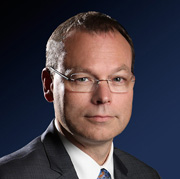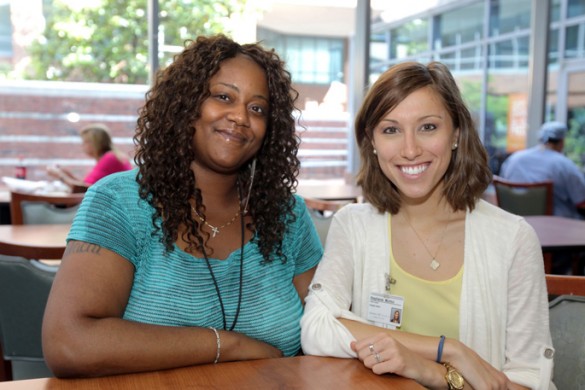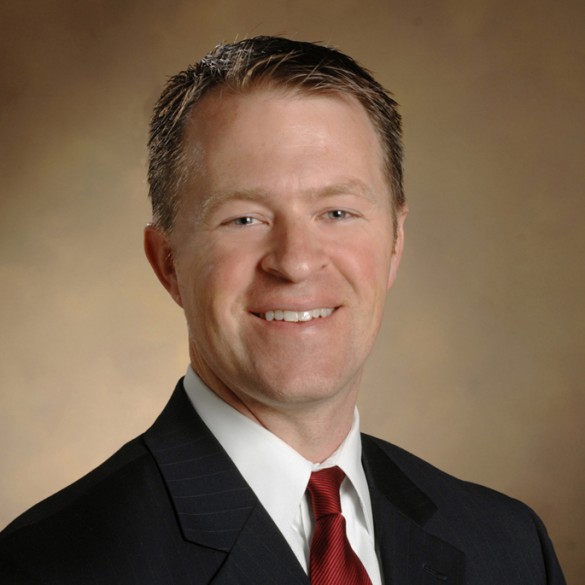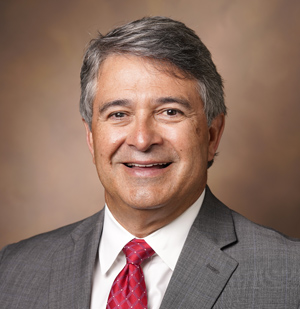Dear Colleagues,
Could anything be more complicated than health care has become — particularly at VUMC where we are educating, discovering and caring for patients all at once?
And with all of the chaos impacting health care, how can we see the future clearly? Health care payment and insurance is perhaps best described as “a hot mess.” And while the sequester deal in December may give slight relief for a short time, the NIH budget is still falling to below early 2000 levels when adjusted for inflation. Our education programs, particularly residency training, are so heavily regulated by outside agencies that the administrative costs are as large as the actual training costs.
At Vanderbilt University Medical Center, we have been through a difficult year. For the first time in the memory of anyone working here, we were forced to lay off hundreds of employees in response to large, sudden reductions in health care and research revenue. We are now seeing many of our peers, coast-to-coast, taking the same deliberate steps.
We saw the tidal wave coming, and we prepared and cut expenses wherever we could. But the truth is, experiencing the impact as it washed over our shores, for a time took our breath away. The rate and pace of change has made what we’ve always felt was solid ground feel like shifting sand.
So as we move forward, how do we develop a sense of confidence amidst such rapid and unprecedented change? How can we gain a sense of perspective?
The truth is, leadership is all about perspective. The problems and challenges we face are epic in proportion, but so are our strengths. And we are an institution that leads.
My goal in “Rounds” this year is to help us build that perspective. As an organization, while experiencing change, we all need a better understanding of the “why,” not just the “what.” As a national leader and huge economic force in our local community, the public depends on all of us — not just to provide the solutions, but to clearly articulate the challenges as complex as they may be.
One way to build perspective around complex problems is to create a framework or scaffold for thinking about them that relates to our common experience. Let’s think of our many challenges as rooms in a house. The problems and challenges become more manageable — and frankly less anxiety provoking — if we mentally place them each into their own separate “room in the house” and consider them separately. We know the challenges all relate to one another, just like family members occupying rooms in a home. But we also know that tackling any challenge requires focus. So let’s begin!
What are the issues that belong on the ground floor — issues that are “foundational?” One is certainly the reduction in revenues we are seeing, both in research and in health care. It probably belongs in the “kitchen,” since we must create revenue growth to keep us going forward. Another ground floor issue is the ever-increasing demand for quality, both in research and health care, as insurers, businesses and individual patients become better educated about “what matters.” Each and every day our sponsors gain greater insight and access to information about the performance of health care providers, hospitals and the researchers they sponsor. I think we should put this “visible quality” issue in the “living room,” as it has a large picture window. Another foundational issue is the patient, and the fact that the entire notion of patient service is changing. Largely through online resources, patients have access to vastly more information about health, and also are, or will be, paying for a larger portion of their own care. So their expectations about their experience with us — both as outpatients and inpatients — are rapidly changing. We might see this as a “family room” issue, as it fundamentally relates to how we and the patient intermingle.
And then there is the massive consolidation we are seeing in both health care and academic research. Hospitals all over the region are being purchased or are affiliating with one another. Vanderbilt is in a very strong position as this occurs, leading the charge in our region with more than 40 hospitals now in our affiliate network, with recent media citing us as the fastest growing nonprofit network in the country. This is a game-changer, and is probably best seen as a second-floor issue, as it is happening in part due to the massive changes in health care revenue on the ground floor. But since our growing network will heavily determine how we can perform research and deliver care in the future, let’s put it in the “master bedroom.”
And the exploding use of “big data,” through the rapid expansion of health information technology in hospitals and clinics at VUMC and across the nation, as a means to improve our care of patients by providing better information to clinicians, as well as for finding clues to better management of entire populations of patients, is also a game-changer. This is a huge strength and strategic advantage for us, as Vanderbilt has been the university world leader in the growing discipline of biomedical informatics for nearly two decades. Since its use must be anchored in the imperative to continuously improve the ground floor issues of quality and service, let’s put it on the second floor as well. And since informatics helps us constantly reconsider how we work, let’s put it in the “study”!
Today, to start the year, let’s focus in depth on the “kitchen” problem — the inexorable, industry-wide revenue declines. We have seen more than $100 million in revenue reductions this year alone, and expect to see $250 million by the end of 2015, despite robust growth in the number of patients receiving our services. As I have described in prior Rounds columns, the causes are many — from federal budget sequestration impacting NIH and Medicare, to aging of the population that reduces our commercial payments relative to Medicare, to our state’s inability to opt in to Medicaid expansion despite a growing uninsured care burden. And all indications are that health care and research revenue will continue to decline. Why? Most people in America under the age of 62 have insurance through their employer which is administered by commercial insurance companies. We expect that over the decade, a significant number of those employers will stop providing this insurance, and instead ask their employees to purchase similar insurance through the state and federal health care exchanges.
While these patients will still have commercial insurance, their choices are many, and will include things like “high deductible” plans that incentivize them to use less health care, avoiding out-of-pocket expense. We also expect that most of these plans will provide somewhat lower payment rates to hospitals and providers than the employer-sponsored plans we have today. Major national employers, including Walgreens and Petco, moved their employees to health insurance exchanges effective Jan. 1, 2014.
As such, the employer-based system we have relied upon since World War II, which was largely insensitive to price as employees received coverage more or less “automatically,” is being replaced by a system where price will matter. Patients will choose their plans with both quality and cost in mind – forcing health care systems like ours to be far more cost-competitive.
At the same time, federal programs supporting research (NIH, NSF – these programs cover 65 percent of our research funding) and health care (Medicare, Medicaid — these programs cover more than half of our patients) will be forced to cut even more cost if they are to remain solvent, as the population over 62 is growing rapidly. For example, the latest reports on Medicare by the U.S. Treasury Secretary indicate that without further cuts, beyond those of sequestration and the Affordable Care Act, by 2026, the hospital trust fund will only be able to pay 87 percent of its claims. And the news is no better for the federal budget deficit, which has already clamped the growth of the NIH budget for research to inflation-adjusted levels below 2004. So for each patient clinic visit, each surgical operation, each research grant — nearly every economist, consultant, and bond-rating agency is forecasting that providers of health care and research will continue to see less and less revenue throughout the decade.
So if I have convinced you that over the remainder of the decade there is going to be an ever-greater challenge obtaining “the groceries needed in our kitchen,” what are the solutions? Having just been through “Evolve to Excel,” we have largely weathered the storm of 2013-14, nearly reducing our costs to be in line with existing revenue. But what about the continued reductions we know are coming in 2015 and beyond? By far, our largest expense is our wages. All other expenses, while significant, are small in comparison to the salaries we pay our people. And over the last two years, we have been highly effective as an organization in minimizing a myriad of non-salary costs.
I am certain that no one, here at Vanderbilt or elsewhere, is enthusiastic about seeing reduced wages relative to inflation. Our people work in the service of health care, research and education in a vast number of ways, and through this work are committed to something larger than themselves. Put simply, you work extraordinarily long hours to give hope to millions. So as we work to improve the nation’s health, we must also maintain and strengthen your economic futures.
When we boil it down, there is really only one solution. Thanks to your tremendous attention to providing world-class care for every person coming through our doors, the number of patients coming to Vanderbilt for outpatient services and inpatient procedures is growing at record levels. And our research grant numbers are also growing steadily, despite unprecedented competition, a testament to the extraordinary quality of your discoveries. So as patient volume and numbers of grants grow, we must find ways to manage that additional workload — safely, effectively and compassionately — without increasing cost.
How? If there were no creative solutions on the horizon, one might despair. But remember Innovation, one of our Five Pillars? At Vanderbilt, we are a national leader in innovation, and many of us are already engaged in developing and piloting the solutions we need. For example, patients with chronic conditions like diabetes and high blood pressure that last years now consume 84 percent of the nation’s health care expense. That’s more than $4 of every $5 spent. Yet most health care systems like ours were designed and organized around the acute care model. We are extraordinarily good — among the very best in the country according to U.S. News and other agencies — at doing what we were designed to do: treating the immediate health care needs of patients. And doing so when they are “inside our walls.”
While I could offer countless examples of innovation at VUMC, I will mention one because it directly relates to how we are getting our heads around ways to more effectively manage chronic disease. It is called MyHealthTeam@Vanderbilt. Drawing on strengths from our informatics programs to expand our reach beyond the clinic walls, in 2010 we set out to transform outpatient management of chronic conditions like high blood pressure, diabetes and heart failure.
The goals were ambitious: to double the quality of care and our capacity to care for more patients without expanding the cost of providing care. Our clinical information systems make it possible to perform continuous surveillance. Rather than interacting with patients primarily during clinic visits, nurses functioning as care coordinators are constantly tracking, educating and coaching patients, with special attention to their personal needs. After some initial success, the project received an “innovation award” from the Centers for Medicare and Medicaid Services (CMS), one of a small number awarded nationally, allowing us to expand the project into our new affiliate network in counties throughout Tennessee and Kentucky. While the program’s outcomes will be under evaluation for the next year, in the first 10,000 patients we are seeing blood pressure control almost twice as effective and less costly when compared to national norms.
Analogous efforts to “change the way we work” are underway across the enterprise, as our researchers are finding less expensive ways to manage the complexities of grant funding, using “pods” crafted to provide research administrative services to more faculty at lower cost. We are also learning to design clinical research studies with more precise outcomes using fewer subjects at far lower cost using BioVU, our world-leading genomics and health informatics resource.
And our educational enterprise, through curriculum 2.0, is both developing and leveraging advanced informatics resources to deliver standard educational content to our students, shifting costly faculty time to where it is needed — helping students integrate new content as they learn, while training students to be more effective when working with patients.
Nonetheless, the paradigm shift — our change in perspective — is that innovation, finding new ways to do things, while part of our general awareness, can no longer be “fringe” activities. Finding better, more cost-effective ways to teach, discover, and deliver care must become part of our daily work — a hardwired part of our routine.
Today, across every clinic, every procedural suite and every research program we must move from our thinking from “innovate when necessary” to doing so as a matter of course, in all areas, all the time.
The good news for all of us at Vanderbilt is that innovation is our sweet spot — its foundation is well established and is already serving as our competitive advantage. No medical center in a five-state region — and I dare say few organizations of any kind in the region — has our capacity for innovation. We are at our core a discovery organization. If you aren’t sure, just ask someone who doesn’t work at VUMC — from anywhere in the country. A national survey of random people in 24 U.S. cities that have never been to Nashville or set foot on our campus, from Los Angeles to Chicago to New York, found one in three associate our medical center with leadership in research and teaching. That number has doubled from only three years ago!
Perspective. This year, when we gathered for holiday festivities, my niece living in San Diego was right there with us — participating in gift opening and other traditions through Skype. I was struck by how remarkably things had changed. Only a short time ago “TV telephone” was something we saw at Disney World exhibits. But here’s the punch line. Her siblings and cousins — including my children in their late-teens and 20s — were not in the least bit impressed. Of course she was there! The next generation of consumers is rising up like a tidal wave, and has entirely different expectations than we do. For example, when they can’t get the banking services they expect online, what do they do? Drive over to the bank to complain? Send in a suggestion for improving service? No, they just “walk.” They simply switch banks. And they do it online at that very moment. The same is true for retail shopping, from clothing and food to entertainment. Two-thirds of consumers shopped online this holiday season, setting yet another record.
The new consumer expects all services, not just banking or retail, to be easy to access, available when they want them, the way they want them, and at the price they are willing to pay.
So what do you suppose they expect from us?
Sincerely,
Jeff Balser, M.D., Ph.D.
Vice Chancellor for Health Affairs and Dean of Vanderbilt University School of Medicine















